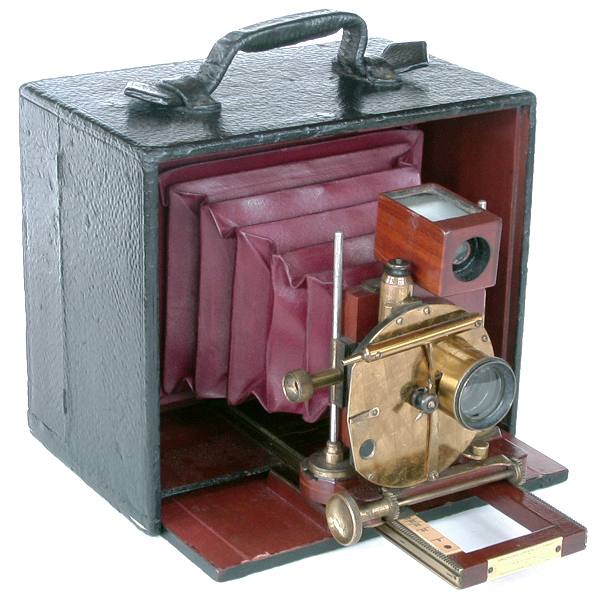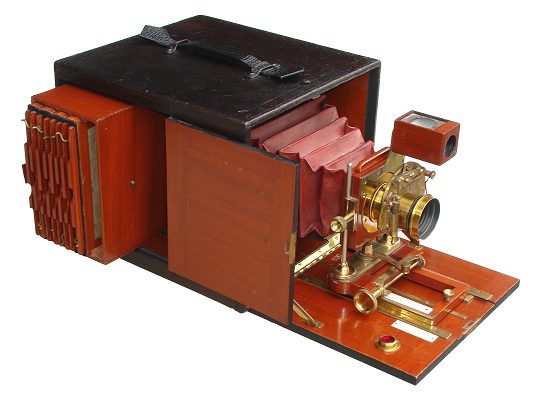|
|






The Henry Clay Camera was introduced in mid-1891,
a period during which the gelatin dry-plate process
was rapidly giving way to rollfilm systems in the
United States. The original 1891 model sold for $50,
or the equivalent of $948 in year 2000 currency.
Henry Clay Cameras were manufactured by the American Optical Company for The Scovill & Adams Company of New York and advertised as the only: Double-Shifting and Swing-Front Hand-Camera.
The Henry Clay Camera, Kodak Folding Camera, Blair Folding Hawk-Eye, and Rochester Premier represented a new generation of self-casing, instantaneous folding cameras; however, the Henry Clay camera was the first self-casing, dry plate camera introduced in the 1890s.
The original sliding-bed model was produced for a short period and is very rare. Examining Henry Clay Camera advertisements and references, the sliding-bed model may have been produced from mid-1891 to late 1892. The second body pattern (hinged bed design) was likely introduced in 1893 (as early as mid-1892) and built during the rest of the production through 1899.
It is unclear why Scovill & Adams abandoned the sliding-bed design in favor of a traditional hinged bedand locking strut arrangement (strut-bed). Although a sliding-bed allows the camera's weight to be directly centered over a tripod or stand, it may have been more prone to breakage and not have a "solid feel" that photographers desired.
Henry Clay Cameras were manufactured by the American Optical Company for The Scovill & Adams Company of New York and advertised as the only: Double-Shifting and Swing-Front Hand-Camera.
The Henry Clay Camera, Kodak Folding Camera, Blair Folding Hawk-Eye, and Rochester Premier represented a new generation of self-casing, instantaneous folding cameras; however, the Henry Clay camera was the first self-casing, dry plate camera introduced in the 1890s.
The original sliding-bed model was produced for a short period and is very rare. Examining Henry Clay Camera advertisements and references, the sliding-bed model may have been produced from mid-1891 to late 1892. The second body pattern (hinged bed design) was likely introduced in 1893 (as early as mid-1892) and built during the rest of the production through 1899.
It is unclear why Scovill & Adams abandoned the sliding-bed design in favor of a traditional hinged bedand locking strut arrangement (strut-bed). Although a sliding-bed allows the camera's weight to be directly centered over a tripod or stand, it may have been more prone to breakage and not have a "solid feel" that photographers desired.
Note: Later research found that what collectors believed to be a shutter by George Wale was actually made by Franz J. Mathein and the patent
assigned to the Scovill & Adams Company. Wale, on the other hand, is a lens maker best known for supplying optics for microscopes.
The Henry Clay Camera, 1891-99
American Optical Co., Scovill & Adams Co., props, NY.
American Optical Co., Scovill & Adams Co., props, NY.
The earliest hinged bed models used a simple brass disk to lock the focusing rails in
place (shown at right). Later models used an improved locking brass screw to
secure the focusing rails.
Henry Clay Camera with later Mathein* Pneumatic Shutter
1891 Sliding-Bed body pattern (original, short lived first model).
1891 Sliding-Bed body pattern (original, short lived first model).
Henry Clay Camera, early hinged bed pattern, c.1893-94
Shown with Prosch Triplex Shutter - Swift Paragon Rapid Lens.
Shown with Prosch Triplex Shutter - Swift Paragon Rapid Lens.
Multi-Lens Cameras | View Cameras | Self-Casing Cameras | Solid Body Cameras | References & Advertisements
Home | What's New | Show Schedule | Wanted | For Sale | Links | Site Map | Email
Home | What's New | Show Schedule | Wanted | For Sale | Links | Site Map | Email
Copyright ©1999 by Rob Niederman - ALL RIGHTS RESERVED
See also:
• The Henry Clay Stereoscopic Camera
• The Henry Clay Regular Camera
• Henry Clay 2d Camera
• Henry Clay Camera Research
Return to the Self-Casing Cameras page
• The Henry Clay Stereoscopic Camera
• The Henry Clay Regular Camera
• Henry Clay 2d Camera
• Henry Clay Camera Research
Return to the Self-Casing Cameras page
When starting on a journey, for it will be found an unfailing source of pleasure, not only while on your trip, but also after returning
home, finishing the pictures made from your own "point of view". -The Henry Clay Cameras product brochure (c1890s)
On occasion, specialized Henry Clay cameras were made to order for clientele. The
example here has an extended rear body. It includes five platerholders that store into a
fitted, custom mahogany case that can be inserted into the camera for storage.
c.1896 Henry Clay Camera: Only known example of an
extended body model. Shown with a Prosch Triplex Shutter.
extended body model. Shown with a Prosch Triplex Shutter.
